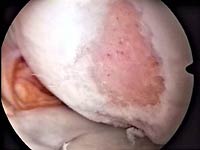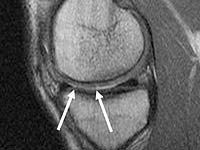MRI successfully evaluated quality of repair tissue after microfracture
MRI detected quality and quantity of repair tissue with 80% sensitivity and specificity.
 A variety of methods, including microfracture,
osteochondral grafting and autologous chondrocyte transplantation, have been
developed to treat chondral defects, but a noninvasive method to assess the
quality of repair tissue has not been established. A recent U.S. study,
however, has demonstrated that MRI is an accurate tool for evaluating the
quality and quantity of repair tissue following microfracture.
A variety of methods, including microfracture,
osteochondral grafting and autologous chondrocyte transplantation, have been
developed to treat chondral defects, but a noninvasive method to assess the
quality of repair tissue has not been established. A recent U.S. study,
however, has demonstrated that MRI is an accurate tool for evaluating the
quality and quantity of repair tissue following microfracture.
Nineteen recreational or high-functioning athletes underwent standard microfracture treatment for 22 traumatic full-thickness chondral defects, said Arun J. Ramappa, MD, of the Steadman-Hawkins Clinic in Vail, U.S.A. Most lesions occurred on the medial femoral condyle; average surface area of the defects was 144 mm2.
The average age of the cohort was 33. Patients underwent repeat arthroscopy for unrelated knee pathology an average of 23 months post-microfracture (range, four months to nine years). MRI studies using specialized sequences were obtained an average of 22 days (range, one to 74 days) prior to second-look arthroscopies.
|
|
|
|
COURTESY OF ARUN J. RAMAPPA |
|
Repair assessment
The repair tissue was assessed for its thickness, its signal and surface congruity. “To be considered good quality tissue, no thinning or minor thinning of the tissue was present, no or mild signal change was present, and the surface was smooth or only minimally incongruous. If each criteria was not present, then the tissue was deemed to be of poor quality,” Ramappa said at the American Orthopaedic Society for Sports Medicine 2004 Annual Meeting.
For the arthroscopies, the repair tissue was characterized using the Outerbridge classification and the level of fill was noted. To be considered good quality, the tissue had to earn a score of between 0 and 2 on the Outerbridge scale, have a smooth texture and a level of fill near normal. If each of these criteria was not present, then the tissue was deemed to be of poor quality.
Arthroscopic assessment showed that 21 of the 22 lesions were fully filled with cartilage repair tissue, and MRI was able to detect the presence or absence of a full-thickness defect in each of these instances. “Arthroscopic assessment showed that 17 of 22 of the lesions, or approximately 80%, were filled with good quality tissue. MRI had good agreement with this, with sensitivities and specificities of approximately 80%.” MRI was equivalent to arthroscopy in detecting full-thickness defects and was good but inferior to arthroscopy in determining the quality of repair tissue.
Ramappa said the limitations of the study include a small sample size, the use of a binary system of evaluation, failure to evaluate the integration of the repair tissue with underlying bone or surrounding cartilage, and patient selection biased to those who had other pathologies after microfracture.
For more information:
- Ramappa AJ, Gill TJ, Bradford CH, Briggs KK, et al. The use of MRI to assess knee cartilage repair tissue after microfracture of chondral defects. Presented at the American Orthopaedic Society for Sports Medicine 2004 Annual Meeting. June 24-27, 2004. Quebec City.


